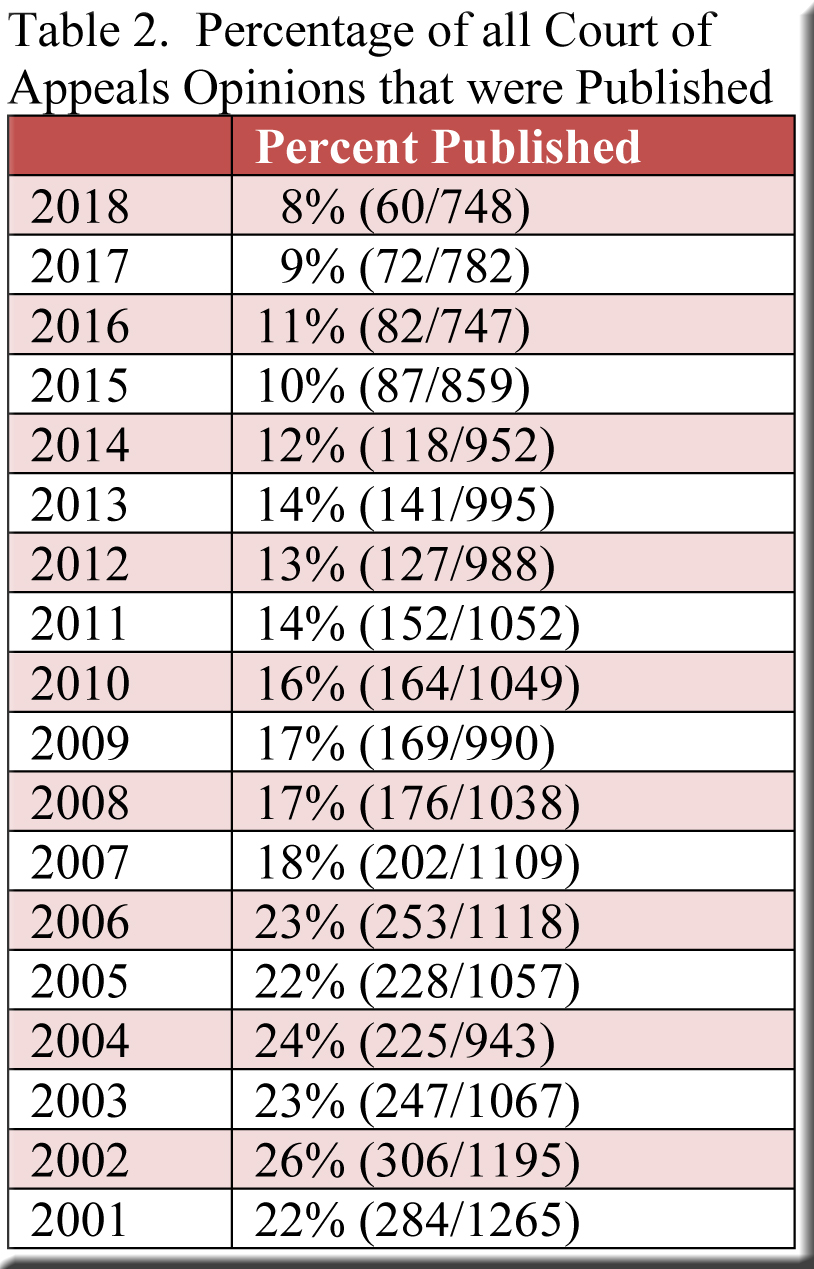A few years ago, a post on the percentage of court of appeals opinions that were issued as per curiam decisions noted the enormous decrease in the total number of court of appeals opinions in recent decades. Today, we’ll return to the field to determine the number and percentage of court of appeals decisions that were published. Given that only published decisions may be cited as precedential authority, they are of primary importance to members of the legal community—who might find the following trends concerning.
Let’s begin with a table and a graph that illustrate the plunging number of published court of appeals decisions—which, in 2018, had dropped by roughly 80% from the total of published decisions less than two decades earlier.[1]
Not only is the decline in the number of published decisions striking, it is even more precipitous than the dramatic reduction of decisions of all types, as displayed in Table 2.[2] During the earliest six years of our period, published decisions always exceeded 20% of all opinions. Thereafter, the figure never reached 20% again, and by the two most recent years, less than 10% of all decisions were published.
Even if we limit ourselves to three-judge opinions, the number that were published has fallen more rapidly than the total, as shown in Table 3.
In 2009, the supreme court allowed unpublished court of appeals decisions to be cited as “persuasive” authority, but this ruling does not appear to have had a discernible effect on trends under consideration here—which were evident well before 2009, and continued thereafter.
Moreover, as the supreme court noted, unpublished decisions, while possibly of “persuasive value,” are not precedent—and thus not binding on Wisconsin courts. Indeed, a judge who encounters a citation to an unpublished decision need not address it at all, and parties have no obligation to research or discuss it.[3] Only published decisions have precedential authority, and far less of this direction is being offered to circuit courts and litigants now than a few years ago, to say nothing of previous decades.
Nor is the supreme court able, any longer, to alleviate the problem. As recently as the mid-1970s, before the formation of the court of appeals, the supreme court alone was filing over twice as many decisions as the number published lately by the court of appeals and the supreme court combined. Since the 1970s, however, the volume of supreme court decisions has diminished at such a rate that the addition of the justices’ output to that of the court of appeals yields an image in Graph 2 very close to that in Graph 1.[4]
The 2019 annual report for the court of appeals should turn up soon on the court’s website, and perhaps it will provide an indication that these trends are abating. In the meantime, I’d be grateful to learn of explanations (or just theories) that could account for the developments described above—and whether litigants ought to be troubled by the dwindling array of precedential guidance.
[1] The data come from the court’s website, which provides calendar-year reports from 2001 through (so far) 2018.
[2] The court’s website indicates that consolidated cases are counted as one.
[3] Wis. Stat. § 809.23. Prior to 2009, unpublished court of appeals decisions could be cited as precedent only in a very limited range of cases. The change in 2009 applied to unpublished decisions that were authored by a three-judge panel or one judge and that were released on or after July 1, 2009.
[4] The very small number of 3-3 per curiam decisions are excluded from the supreme court data.





Thanks so much for this. So, you mention that the 2009 rule change didn’t have a discernible effect on the percentage of published decisions. But I think the more interesting part–for me, anyway–is that the number of “3-judge opinions” in your chart (by which I assume you mean authored decisions, given the numbers) has fallen radically since 2009.
Thank you for the comment. Yes, the 3-judge opinions are authored (some published, some not).
What we’ve anecdotally thought we noticed since the rule change is an increase in per curiam decisions and summary dispositions in 3-judge decisions. And your numbers seem to confirm this, if I’m reading the numbers right.